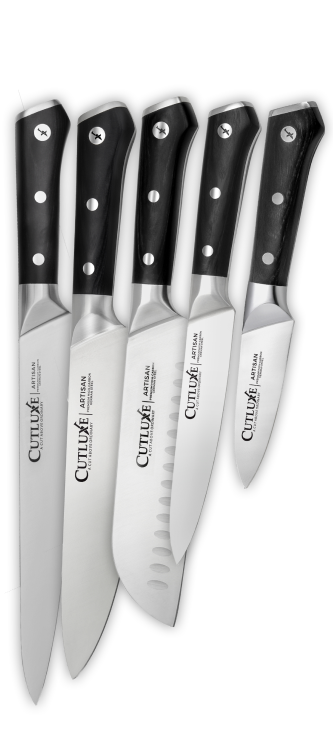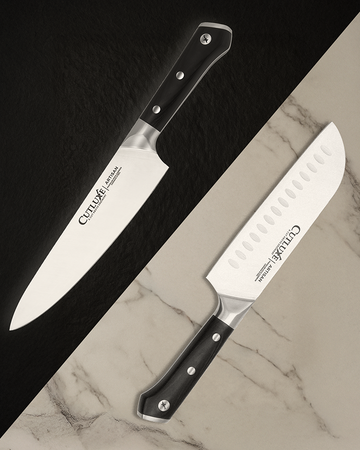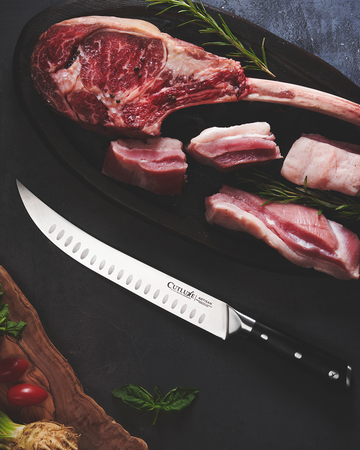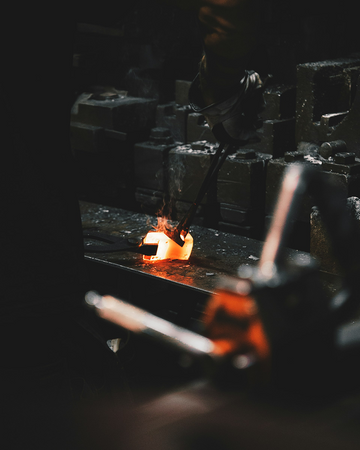Knife Shapes and Designs – More Than Just Aesthetic
A knife’s shape is more than a stylistic choice. Each curve and angle serves a specific function in the kitchen. From the gentle curve of a chef’s knife to the straight edge of santoku knives, the design is closely tied to how the knife performs during various cooking tasks.
A well-designed knife doesn’t just look good on a magnetic strip; it handles beautifully, allowing for precision, power, and safety. For example, the wider blade of a butcher’s knife gives strength and weight for cutting through tough meat, while a narrow boning knife provides flexibility and control for delicate tasks. These differences and types aren’t decorative; they’re purposeful.
Cooking Knife Shapes and What They’re For
Each knife type has a specific job. Here’s a quick guide:
- Chef’s knife: A versatile tool for chopping, slicing, and dicing. Its curved edge supports a rocking motion and a comfortable handle designed for prolonged use.
- Santoku knife: Designed for precision, featuring a flatter edge that is ideal for push cuts and fine slicing, paired with an ergonomic handle for better grip.
- Butcher knife: Heavier, with a broader blade — perfect for breaking down meat.
- Utility knife: Narrower and lighter — good for slicing smaller fruits or sandwiches.
- Paring knife: Compact and sharp — best for peeling and small cuts.
Choosing the right knife type makes your cooking faster, easier, and more enjoyable.
Types of Knife Points and Their Purposes
Even the point of a knife matters. A sharp, tapered point is useful for piercing tasks — think deveining shrimp or scoring dough. A rounded point, like on some santoku knives, is safer for quick chopping. Meanwhile, a sheep’s foot design keeps the tip flat and controlled for tasks like julienning or fine dicing, making these knives a versatile choice for many kitchen needs.
Understanding these subtle differences helps you match the knife’s handle design and shape to your daily tasks.

- Razor-sharp German blades
- Full tang for perfect balance
- Pakkawood ergo handle grip
- Complete set for daily prep
- Sleek, durable, and versatile
- Pro-grade knives for chefs
- Lightweight feel
- Heavy-duty cuts
- Ideal for home and pro
- Lifetime warranty included
Knife Blade Style and Performance in the Kitchen
A blade’s style, type, and shape directly affect how your knives perform. Whether you’re slicing tomatoes or trimming brisket, the blade surface plays a role in food release, precision, and effort. Some blades are polished smooth, while others feature dimples or hollow edges to reduce sticking. At Cutluxe, our knives are engineered with various blade styles and handle designs to match how you cut and what you’re cutting. Choosing the right knife style ensures your knives work with you (not against you) every time you step into the kitchen.
Blade Geometry and Food Release
Blade geometry refers to the cross-sectional shape of the knife. A thin, tapered blade will glide easily through vegetables, but may be prone to bending under pressure. A wider, wedge-shaped blade adds strength and keeps food from sticking. Choosing the right knife geometry, shape, and handle design can make a noticeable difference in performance, while the wrong knife design can slow you down in the kitchen.
Some of our chef’s knives include a Granton edge — shallow dimples along the blade that reduce friction and let slices fall cleanly away. It’s not just about looking cool; it’s about improving your rhythm and speed in the kitchen. The right knife geometry, shape, style, and handle design can turn an ordinary cut into a clean, confident motion, and the wrong knife can slow you down or make prep work frustrating. Every knife in the Cutluxe lineup is designed to maximize both efficiency and comfort.
Sharpening and Maintenance Tips by Blade Style
Different blade styles require different care. A polished blade is easier to clean and hone, while a serrated blade is more difficult to sharpen at home and may need professional servicing. Flat-edged knives benefit from regular honing, while hollow-edge knives may need less frequent touch-ups. No matter the knife style, maintaining your knife properly (including caring for the handle) ensures lasting performance and safer, smoother cutting.
To keep your knives sharp and long-lasting:
- Use a honing rod weekly for polished knife blades.
- Wash by hand to protect the edge and knife handle.
- Store in a knife block or magnetic strip — not loose in drawers.
- For serrated styles, consider occasional professional knife sharpening.
Most Comfortable Knife Handle for Everyday Use
A knife can have the sharpest blade in the world, but if the handle is uncomfortable or unbalanced, you won’t enjoy using it. The handle plays a huge role in how the knife feels and how long you can cook without fatigue or strain.
At Cutluxe, we design our handles to deliver perfect ergonomics, blending form with function and emphasizing the shape that fits your hand best. Whether you're prepping for a quick lunch or cooking for a crowd, a well-designed handle gives you the grip, balance, and confidence you need. A great knife isn't just about the cut; it's about how the knife supports your hand through every step of your prep. Choosing the right knives can make all the difference in comfort and performance, especially during long cooking sessions.
Ergonomic vs Traditional Handle Shapes
Ergonomic knives’ handles are contoured to fit the natural curves of your hand. They reduce wrist tension and offer better control, especially when working with dense or slippery foods. Traditional handle styles, often found in classic European knives, are straight and symmetrical, which can be less comfortable during extended use. The right knife handle can transform how you prep, while the wrong knife choice can quickly lead to fatigue. That’s why selecting ergonomic knives makes all the difference in long cooking sessions.
Both knives’ designs have their place, but for everyday cooking, most chefs prefer ergonomic handles for the added comfort and secure grip. Choosing the right knife isn’t just about sharpness; it’s about how the knife feels after hours in the kitchen.
Knife Handle Balance and Long-Term Use
A well-balanced knife puts less strain on your wrist and makes long prep sessions feel effortless and more comfortable. This balance comes from carefully pairing the blade weight with the knives’ handle style and materials — often stabilized wood, pakkawood, or composites that resist moisture and wear.
Cutluxe handles are built with comfort and durability in mind, designed to stay secure even with wet or oily hands. When a knife feels like a natural extension of your hand, every cut becomes more precise and more enjoyable. The better the knife is balanced to your grip, the easier and safer your prep will be.











